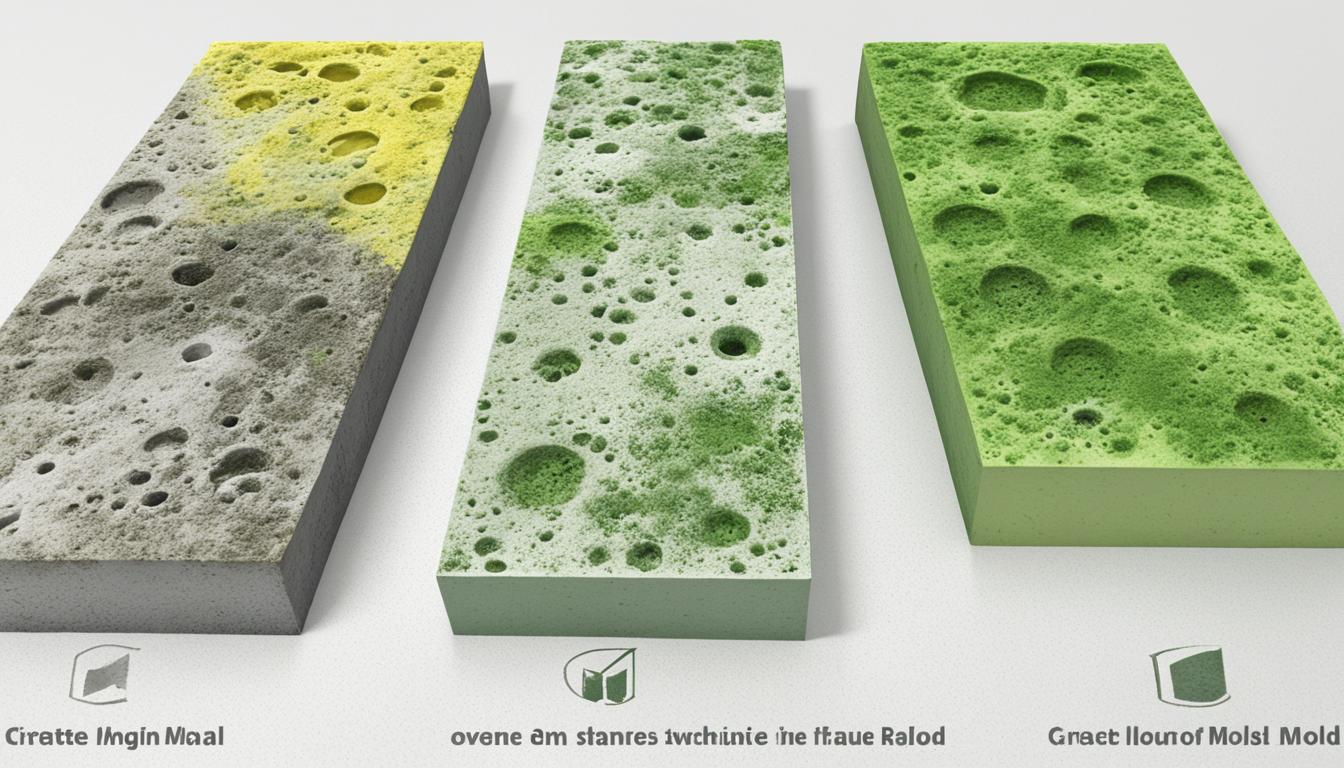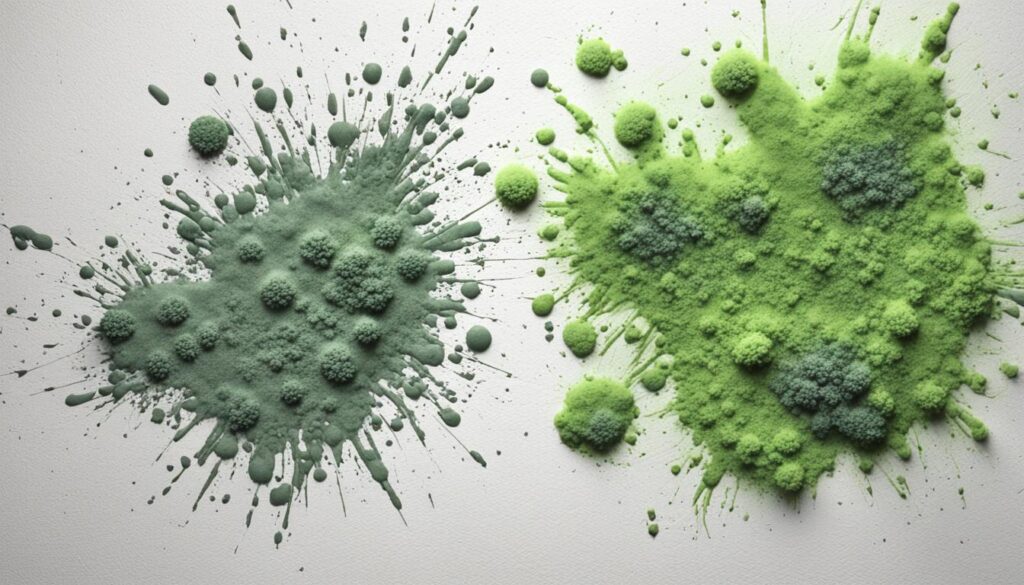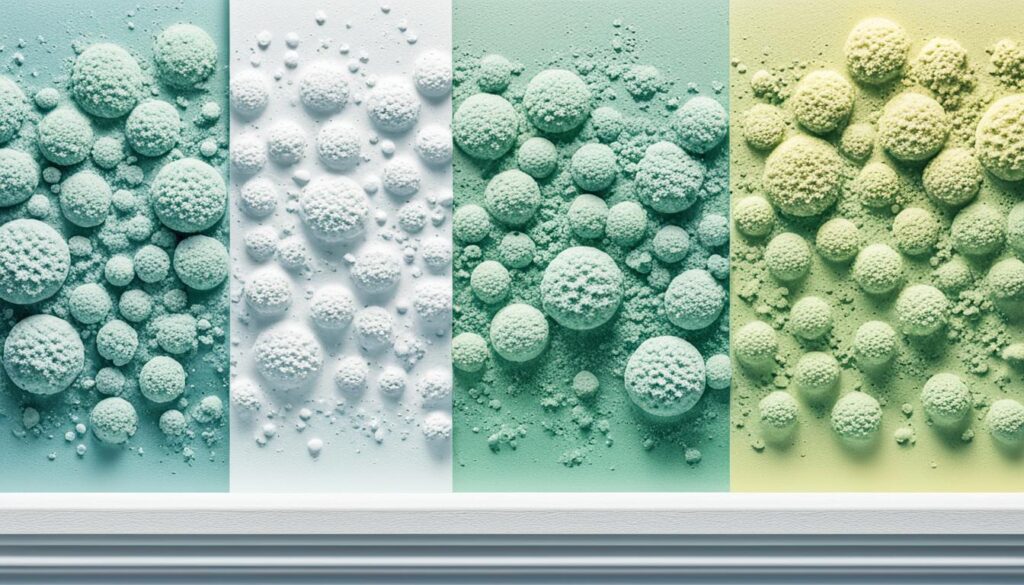
Different Types of Mold & Their Prevalence – FAQ
Welcome to our comprehensive guide on the different types of mold and their prevalence in homes and businesses. Mold is a common issue that can cause various health problems and damage to property. By understanding the different mold types, their classification, and where they are commonly found, you can take proactive measures to prevent and remedy mold issues in your indoor environment.
In this article, we will provide an overview of the various mold classifications, including the different categories, species, and strains that exist. We will also explore the common mold varieties found in both residential and commercial settings, discussing their characteristics and potential health risks.
Additionally, we will examine the prevalence of mold in homes and businesses, highlighting the factors that contribute to mold growth and the importance of mold prevention and remediation. We will also discuss how to identify mold infestations and the importance of professional mold assessments.
Furthermore, we will delve into effective strategies for preventing mold growth in indoor spaces and the various remediation methods available for dealing with existing mold issues. By implementing these prevention and remediation techniques, you can ensure a healthy indoor environment for yourself, your family, or your employees.
Stay tuned for our upcoming sections, where we will explore each topic in detail and provide valuable insights to help you navigate the world of mold. Let’s get started!
Key Takeaways:
- Understanding the different types of mold is important for proactive mold management.
- Mold can be classified into various categories, species, and strains.
- Common mold varieties can be found in both residential and commercial settings.
- Mold prevalence in homes and businesses can lead to health issues and property damage.
- Identifying mold infestations and seeking professional assessments is crucial.
Understanding Mold Classification
When it comes to mold, understanding its classification is crucial in order to effectively identify and address mold-related issues. Mold is classified based on various factors, including its species, strains, and categories. By categorizing mold, we can gain a better understanding of its characteristics and potential health risks.
Mold Classification System:
| Category | Species | Strains |
|---|---|---|
| Indoor Mold | Aspergillus | Aspergillus fumigatus |
| Penicillium | Penicillium chrysogenum | |
| Outdoor Mold | Cladosporium | Cladosporium herbarum |
| Alternaria | Alternaria alternata |
There are common mold varieties within each category that are frequently encountered. For example, Aspergillus and Penicillium are two prevalent species found indoors, while Cladosporium and Alternaria are commonly found outdoors. These mold varieties can vary in appearance, growth patterns, and potential health effects.
Common Mold Varieties:
- Aspergillus: This mold variety is often found in damp areas and can produce mycotoxins, which may cause respiratory issues.
- Penicillium: Known for its green or blue fungal growth, Penicillium can contaminate food items and release allergens that can trigger allergic reactions.
- Cladosporium: This black or dark green mold thrives in both indoor and outdoor environments and can cause respiratory symptoms, especially in individuals with weakened immune systems.
- Alternaria: Commonly found in damp areas such as bathrooms and kitchens, Alternaria can trigger asthma symptoms and allergic reactions in sensitive individuals.
Understanding the different mold species, strains, and categories is essential for effective mold management and remediation. By recognizing the common mold varieties and their potential health risks, homeowners and businesses can take appropriate measures to prevent mold growth and create a healthier indoor environment.
Common Mold Varieties Found in Homes
When it comes to the presence of mold in homes, several common mold varieties are frequently encountered. Understanding these mold types is essential for homeowners to identify and address potential health risks. Let’s explore some of the most prevalent mold species and their characteristics:
1. Cladosporium
“Cladosporium is one of the most widespread mold species found indoors.”
Cladosporium is a type of mold commonly found on wallpaper, carpets, and other organic matter. It appears as green, brown, or black spots and can affect both indoor and outdoor environments. Individuals with respiratory conditions or weakened immune systems may experience allergic reactions or respiratory symptoms in the presence of Cladosporium.
2. Penicillium
“Penicillium is known for its rapid growth and ability to produce airborne spores.”
Penicillium is commonly found in damp or water-damaged areas such as basements, bathrooms, and kitchens. It appears as fuzzy, greenish-blue colonies and can pose health risks, especially for individuals with allergies or compromised immune systems. Inhalation of Penicillium spores may lead to respiratory issues and allergic reactions.
3. Aspergillus
“Aspergillus is a diverse mold genus, with various species having different health implications.”
Aspergillus mold is often found in damp indoor environments and may grow on building materials, soil, or decomposing plant matter. The presence of Aspergillus can cause respiratory infections, allergic reactions, or even more severe health conditions in individuals with weakened immune systems. Different species of Aspergillus have varying health implications, with Aspergillus fumigatus being one of the most clinically significant.
It is crucial to note that the identification of mold species requires professional expertise. If you suspect mold growth in your home, consider consulting a certified mold inspector for accurate identification and appropriate remediation measures.
Next, we will explore the various types of mold commonly found in commercial settings, shedding light on the unique challenges faced by businesses in maintaining mold-free environments.

Mold Types in Commercial Settings
Commercial buildings are not immune to mold growth, and the presence of mold in these settings can have a significant impact on indoor air quality. Understanding the types of mold commonly found in commercial environments is essential for effective mold management and prevention.
There are several mold types that are frequently encountered in commercial buildings. Here are some of the most common mold varieties:
| Mold Type | Description |
|---|---|
| Stachybotrys Chartarum | This mold, commonly known as black mold, thrives in damp environments and is often found in areas with water damage or high humidity levels. |
| Aspergillus | Aspergillus is a type of mold that can colonize various surfaces, including HVAC systems, carpeting, and insulation. It can cause respiratory issues and allergic reactions in susceptible individuals. |
| Penicillium | Penicillium molds are often found in buildings with water intrusions or high moisture levels. They have a distinct musty odor and can cause respiratory problems and allergic reactions. |
| Cladosporium | Cladosporium is a common household mold that can also thrive in commercial settings. It can grow on various surfaces, including fabrics, carpets, and wallpaper. |
These mold strains and species are just a few examples of the diversity of mold types that can be found in commercial buildings. The presence of mold in these settings can lead to a range of problems, including adverse health effects, structural damage, and negative impacts on employee productivity.
Preventing Mold Growth in Commercial Buildings
To prevent mold growth in commercial buildings, it is crucial to address moisture issues promptly and maintain proper ventilation. Regular inspections should be conducted to identify and rectify any water leaks or sources of excess humidity. Additionally, implementing a comprehensive mold prevention plan that includes routine cleaning and maintenance can help minimize the risk of mold growth.
Professional mold assessments and remediation should be performed if mold is detected in a commercial building. Trained professionals can identify the type of mold present, assess the extent of the infestation, and implement appropriate remediation measures to eliminate the mold and restore indoor air quality.
Mold Prevalence in Homes and Businesses
In both residential properties and commercial settings, mold growth is a common concern that can negatively impact indoor air quality and the health of occupants. Understanding the prevalence of mold and the factors that contribute to its growth is essential for effective prevention and remediation.
Factors Contributing to Mold Growth
Mold thrives in environments with excess moisture and organic matter, making homes and businesses vulnerable to infestations. Some factors that can contribute to mold growth include:
- Poor ventilation
- High humidity levels
- Water leaks or flooding
- Damp basements or crawl spaces
- Condensation on windows or pipes
These conditions create a breeding ground for mold spores to settle and proliferate, leading to the appearance of visible mold growth and potential health issues for occupants.
Mold Prevalence in Homes
Residential properties are susceptible to various types of mold, which can be found in different areas depending on the conditions present. Common mold varieties often found in homes include:
| Mold Type | Preferred Areas of Growth |
|---|---|
| Stachybotrys chartarum (Black mold) | Damp areas, such as bathrooms and basements |
| Aspergillus | Wall cavities, air vents, and HVAC systems |
| Cladosporium | Basements, bathrooms, and areas with moisture issues |
Understanding the characteristics of these mold varieties and their potential health risks is crucial for homeowners in their efforts to maintain a safe and healthy living environment.
Mold Prevalence in Businesses
Commercial buildings are also susceptible to mold growth, posing potential health risks to employees, customers, and occupants. Mold types commonly found in commercial settings include:
| Mold Type | Preferred Areas of Growth |
|---|---|
| Aspergillus | Basements, attics, and areas with poor ventilation |
| Penicillium | Water-damaged building materials and HVAC systems |
| Alternaria | Damp areas, such as bathrooms and kitchens |
Due to the large size and complex nature of commercial buildings, mold prevention and remediation require specialized expertise and comprehensive strategies.

In the next section, we will discuss how to identify mold infestations and the importance of professional mold assessments to ensure accurate diagnosis and effective mold management.
Identifying Mold Infestations
In order to effectively address a mold problem, it is crucial to first identify the presence of mold in your home or business. Recognizing the signs and symptoms of a mold infestation can help you take prompt action and prevent further damage to your property and health.
Common Signs of Mold
Mold can manifest in various ways, and its appearance may differ depending on the type of mold and the surface it grows on. Some common signs of mold infestation include:
- Visible discoloration: Mold often appears as black, green, or white patches on walls, ceilings, or other surfaces.
- Musty odor: A strong, unpleasant smell, similar to dampness or rot, may indicate the presence of mold.
- Persistent moisture: Mold thrives in damp environments, so if you notice recurring water leaks, condensation, or high humidity levels, it increases the risk of mold growth.
- Allergy-like symptoms: Mold spores can trigger allergic reactions, causing symptoms such as sneezing, coughing, watery eyes, and skin irritation.
- Respiratory issues: Prolonged exposure to mold can lead to respiratory problems, including asthma attacks, wheezing, and difficulty breathing.
The Importance of Professional Mold Assessments
While some mold infestations may be easily detected, others can be hidden within walls, ceilings, or under flooring. In such cases, it is crucial to seek professional mold assessments to accurately identify the extent of the infestation and determine the appropriate remediation measures.
Professional mold assessments involve thorough inspections conducted by certified mold inspectors. These experts possess the knowledge, experience, and specialized equipment to detect hidden mold and assess the indoor air quality. Through their assessments, they can provide valuable insights into the types of mold, classify their level of severity, and recommend suitable remediation strategies.
By relying on professional mold assessments, you can gain a comprehensive understanding of the mold issues in your property and develop an effective plan to address and mitigate the problem.
| Type of Mold | Description | Potential Health Risks |
|---|---|---|
| Stachybotrys chartarum (Black Mold) | A greenish-black mold that thrives in areas with prolonged moisture. Commonly found in materials with high cellulose content like drywall or wood. | Can cause respiratory issues, sinusitis, fatigue, and irritate allergies. |
| Aspergillus | A common mold species that comes in various colors, including green, yellow, or brown. Found in damp areas, such as bathrooms or kitchens. | May cause respiratory infections, allergic reactions, and worsen asthma symptoms. |
| Penicillium | A blue or green mold commonly found in areas with water damage or excessive humidity. It can spread quickly and produce musty odors. | Known to cause respiratory issues, allergies, and sinus infections. |
Preventing and Remedying Mold Issues
Mold growth can pose serious health risks and cause extensive damage to homes and businesses. Therefore, it is essential to take proactive measures to prevent mold infestations and promptly address any existing mold issues. In this section, we will explore effective strategies for mold prevention and various remediation methods to combat mold growth.
Preventing Mold Growth
To prevent mold growth in homes and businesses, it is crucial to maintain dry and clean indoor environments. Here are some key preventive measures:
- Keep indoor humidity levels below 50% by using air conditioners or dehumidifiers.
- Address any leaks or water damage promptly to prevent moisture buildup.
- Ensure proper ventilation in bathrooms, kitchens, and other areas prone to moisture.
- Avoid carpeting in areas prone to moisture, such as basements or bathrooms.
- Regularly clean and dry areas where moisture tends to accumulate, such as shower curtains, window sills, and air conditioning units.
By implementing these preventive measures, you can significantly reduce the risk of mold growth in your living or working spaces.
Remediation Methods
If you discover mold in your home or business, it is crucial to address the issue promptly to prevent further damage. Mold remediation involves the following steps:
- Identify the source: Determine the cause of mold growth and address any underlying issues, such as leaks or high humidity.
- Containment: Isolate the affected area to prevent the spread of mold spores to other parts of the building.
- Removal: Remove visible mold using appropriate cleaning agents and techniques, ensuring complete eradication.
- Dehumidification: Reduce indoor humidity levels to discourage mold regrowth.
- Repair: Repair any damaged materials or surfaces affected by mold growth.
- Prevention: Implement preventive measures to avoid future mold infestations.
Professional Mold Remediation
In cases of extensive mold infestations or when dealing with toxic mold varieties, it is advisable to seek professional mold remediation services. Qualified mold remediation specialists have the expertise and specialized equipment to effectively remove mold, ensure proper containment, and restore the affected areas to a safe and mold-free condition.
Remember, mold prevention is key to maintaining a healthy indoor environment. Regular inspections, prompt repairs, and proper moisture control are essential for mold prevention. By being proactive and taking appropriate remediation measures, you can protect yourself, your family, and your property from the harmful effects of mold.
Conclusion
In conclusion, understanding the different types of mold and their prevalence is essential for maintaining a healthy indoor environment. Mold can be classified into various categories, species, and strains, each with its own characteristics and potential health risks.
Common mold varieties can be found in both residential and commercial properties, impacting indoor air quality. Mold growth can be influenced by factors such as moisture, humidity, and poor ventilation. Identifying mold infestations is crucial, as they can lead to respiratory issues, allergies, and other health problems.
To prevent and remedy mold issues, proactive management is crucial. Taking steps to prevent mold growth, such as maintaining proper ventilation and reducing excess moisture, can help mitigate the risk. When dealing with existing mold problems, professional mold remediation methods should be employed to ensure thorough removal and minimize the chances of mold recurrence.
By being aware of the different types of mold, recognizing the signs of infestation, and implementing preventive measures, we can create healthier indoor spaces for ourselves and others. Remember, proactive mold management is key to maintaining a safe and comfortable living or working environment.




